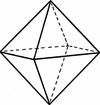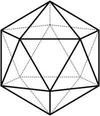Level 1C Flashcards
1
Q
Evaluate 132.
A
169
2
Q
Evaluate 162
A
256
3
Q
Evaluate 192
A
361
4
Q
Evaluate 212.
A
441
5
Q
Evaluate 242
A
576.
6
Q
Evaluate 272
A
729.
7
Q
Evaluate 302
A
900
8
Q
Evaluate 43
A
64
9
Q
Evaluate 63
A
216
10
Q
Evaluate 83
A
512
11
Q
Evaluate 103
A
1000
12
Q
Evaluate 123
A
1728
13
Q
Evaluate 143
A
2744
14
Q
Evaluate 25
A
32
15
Q
Evaluate 28
A
256
16
Q
Evaluate 211
A
2048
17
Q
Evaluate 214
A
16384
18
Q
What are the five platonic solids?
A
Tetrahedron, Hexahedron (Cube), Octahedron, Dodecahedron, Icosahedron.

19
Q
Describe the characteristics of a tetrahedron.
A
A tetrahedron has the following properties:
1) 4 equilateral triangle faces
2) 4 vertices
3) 6 edges

20
Q
Describe the characteristics of a hexahedron (cube).
A
A hexahedron has the following characteristics:
1) 6 square faces
2) 8 vertices
3) 12 edges





